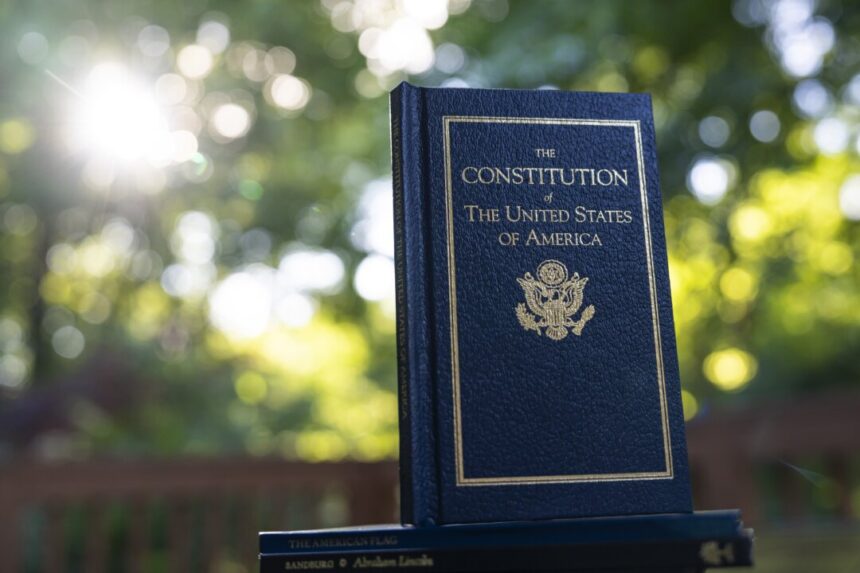Commentary
In 1936, a young man came to the nation’s capital to work for the FBI. He did his FBI job during the daytime and attended law school at George Washington University at night. He asked his law professor for a good book on the U.S. Constitution and was given one that was three inches thick. In the process of looking for a simple and straightforward book about the Constitution, he ended up reading all the writings by the Founding Fathers, including the Federalist Papers, the notes of the Constitutional Convention in Philadelphia, and most of the correspondence between the key Founding Fathers at that time. Eventually, he created such a book about the Constitution himself, called “The Five Thousand Year Leap.”
That is the story of Cleon Skousen and how I, a Chinese-American software engineer turned journalist, learned about the U.S. Constitution and the crystal-clear principles that it embodies. I was so awed by the thinking of the Founding Fathers that I developed an online course to teach my audience about the precious knowledge I had gained.
The course triggered so much interest among my first-generation immigrant students that one of them, a businessman, decided to go back to law school to learn about the Constitution formally.
When I later asked him about what he had learned in law school, he said, “Oh, they just taught Supreme Court case rulings.”
I should have been shocked, but I wasn’t, as I know that has been happening for the last 100 years, and I know the reasons behind it.
The Agenda of Communism
After communism emerged in Europe in the mid-1800s, its proponents intended to usher the United States onto its track. However, communists ran into great difficulty, as the U.S. Constitution effectively blocked their agenda of extending government power, abolishing private property, and redistributing wealth.
In 1895, the Fabian socialists complained: “England’s [unwritten] Constitution readily admits of constant though gradual modification. Our American Constitution does not readily admit of such change. England can thus move into socialism almost imperceptibly. Our Constitution, being largely individualistic, must be changed to admit of socialism, and each change necessitates a political crisis.”
Short of ways to amend the Constitution into what socialists wanted—which would have to overcome a significant amendment hurdle—another route was to reinterpret the Constitution through the courts. This effort began at the law schools of the most elite universities in the United States.
‘Legal Realism’ at Harvard Law School
Professor Paul Skousen, in his book “The Naked Socialist,” recorded such an effort. In the 1870s, a Harvard law professor named Christopher Columbus Langdell became the dean of Harvard Law School. He spent two decades guiding law students onto the path of “casebook study.”
Casebook study dropped the thinking and design behind the Constitution of the Founders as the basis for judgment. Instead, it encouraged students to learn about the interpretation of the Constitution by the Supreme Court justices over time, which was influenced by the justices’ own knowledge, experience, political leanings, and even bias.
The next Harvard Law School professor, Roscoe Pound, who became the dean in 1916, took it one step further and helped start a movement called “Legal Realism.”
Legal Realism intentionally encourages law students to treat the Constitution as a living document and to interpret it according to the needs of the society of their time, while its opposite, “Legal Formalism,” requires justices to resort only to the original meaning of the Constitution at the time of its creation.
Legal Realism unleashed law students who later became judges or justices of the Supreme Court, allowing for a liberal interpretation in a justified way.
The Drifting of the Supreme Court
The Supreme Court began to replace Congress as the place to “write” laws, as seen in United States v. Butler (1936), which removed restrictions on taxing and spending, directly violating Article I, Section 9 of the Constitution. Similarly, Everson v. Board of Education (1947) forced the First Amendment’s establishment clause onto the individual states and drove religious teaching out of public schools, violating the 10th Amendment: “The powers not delegated to the United States by the Constitution, nor prohibited by it to the States, are reserved to the States respectively, or to the people.”
Since then, the Supreme Court has ruled on dozens of so-called “milestone cases” that violate the original intent of the Constitution and set the great law of our nation adrift over time.
Dean Roscoe Pound’s approach to teaching law has also sent thousands of law students into the United States with the mistaken belief that they are empowered to create law if the situation warrants it. It is a Fabian socialist’s dream of changing America come true.
Thomas Jefferson’s View
One of the Founding Fathers, Thomas Jefferson, wrote in 1823, “On every question of construction, [let us] carry ourselves back to the time when the Constitution was adopted, recollect the spirit manifested in the debates, and instead of trying what meaning may be squeezed out of the text, or invented against it, conform to the probable one in which it was passed.”
He refers to it as the enduring Constitution.
If you’re curious about why our nation has undergone such drastic changes and why the Supreme Court has failed to protect what we once had, this is one of the reasons.
And if you’re wondering why law students today don’t study the Constitution in the same way Cleon Skousen did in the 1930s—learning it directly from the Founding Fathers who created it, but rather second-hand from Supreme Court justices—now you know the reason.
Opinions expressed in this article are solely those of the author and do not necessarily reflect the views of The Epoch Times.






